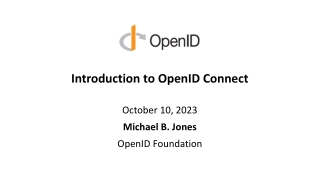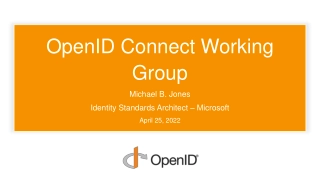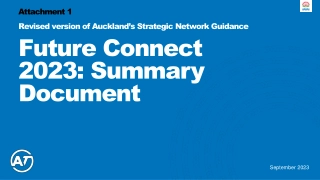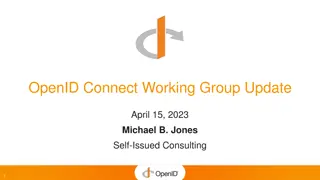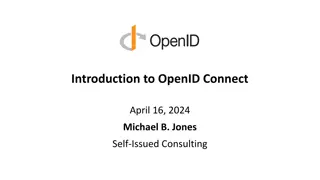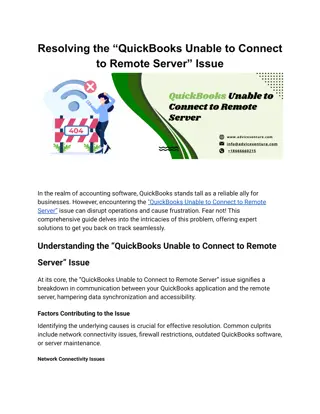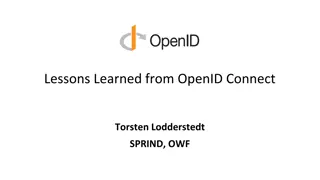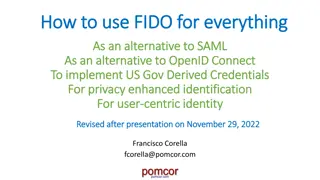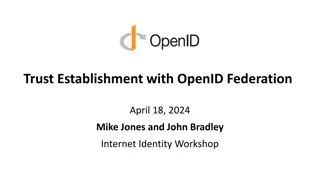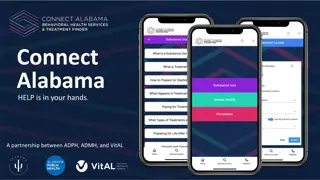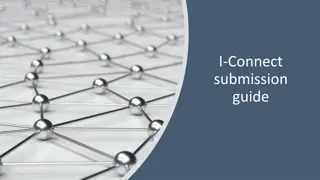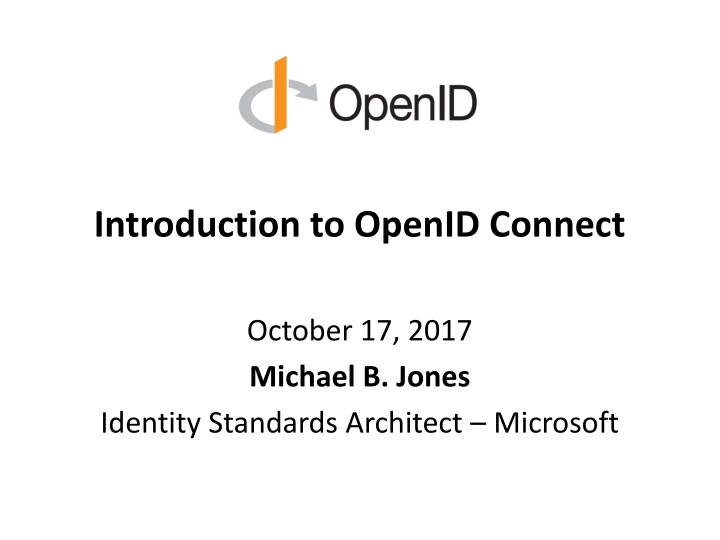
OpenID Connect: A Simple Identity Layer
Discover the simplicity and versatility of OpenID Connect, a system built on top of OAuth 2.0 that allows for easy verification of user identities and access to basic profile information. Learn how it is used by major companies and how it can be implemented across various platforms for a seamless experience.
Download Presentation

Please find below an Image/Link to download the presentation.
The content on the website is provided AS IS for your information and personal use only. It may not be sold, licensed, or shared on other websites without obtaining consent from the author. If you encounter any issues during the download, it is possible that the publisher has removed the file from their server.
You are allowed to download the files provided on this website for personal or commercial use, subject to the condition that they are used lawfully. All files are the property of their respective owners.
The content on the website is provided AS IS for your information and personal use only. It may not be sold, licensed, or shared on other websites without obtaining consent from the author.
E N D
Presentation Transcript
Introduction to OpenID Connect October 17, 2017 Michael B. Jones Identity Standards Architect Microsoft
Working Together OpenID Connect
What is OpenID Connect? Simple identity layer on top of OAuth 2.0 Enables RPs to verify identity of end-user Enables RPs to obtain basic profile info REST/JSON interfaces low barrier to entry Described at http://openid.net/connect/
Youre Probably Already Using OpenID Connect! If you log in at AOL, Deutsche Telekom, Google, Microsoft, mixi, NEC, NTT, Salesforce, Softbank, Symantec, Verizon, or Yahoo! Japan or have an Android phone, you re already using OpenID Connect Many other sites and apps large and small also use OpenID Connect
OpenID Connect Range Spans use cases, scenarios Internet, Enterprise, Mobile, Cloud Spans security & privacy requirements From non-sensitive information to highly secure Spans sophistication of claims usage From basic default claims to specific requested claims to collecting claims from multiple sources Maximizes simplicity of implementations Uses existing IETF specs: OAuth 2.0, JWT, etc. Lets you build only the pieces you need
Presentation Overview Introduction Design Philosophy Timeline A Look Under the Covers Overview of OpenID Connect Specs More Connect Specs OpenID Certification Resources
Design Philosophy Keep Simple Things Simple Make Complex Things Possible
Simple Things Simple UserInfo endpoint for simple claims about user Designed to work well on mobile phones
How We Made It Simple Built on OAuth 2.0 Uses JavaScript Object Notation (JSON) You can build only the pieces that you need Goal: Easy implementation on all modern development platforms
Complex Things Possible Encrypted Claims Aggregated Claims Distributed Claims
Key Diffs from OpenID 2.0 Support for native client applications Identifiers using e-mail address format UserInfo endpoint for simple claims about user Designed to work well on mobile phones Uses JSON/REST, rather than XML Support for encryption and higher LOAs Support for distributed and aggregated claims Support for session management, including logout Support for self-issued identity providers
OpenID Connect Timeline Artifact Binding working group formed, Mar 2010 Major design issues closed at IIW, May 2011 Result branded OpenID Connect Functionally complete specs, Jul 2011 5 rounds of interop testing between 2011 and 2013 Specifications refined after each round of interop testing Won Best New Standard award at EIC, April 2012 Final specifications approved, February 2014 Errata set 1 approved November 2014 Form Post Response Mode spec approved April 2015 OpenID 2.0 to Connect Migration spec approved April 2015 OpenID Provider Certification launched April 2015 Relying Party Certification launched December 2016 Logout Implementer s Drafts approved March 2017
A Look Under the Covers ID Token Claims Requests UserInfo Claims Example Protocol Messages
ID Token JWT representing logged-in session Claims: iss Issuer sub Identifier for subject (user) aud Audience for ID Token iat Time token was issued exp Expiration time nonce Mitigates replay attacks
ID Token Claims Example { "iss": "https://server.example.com", "sub": "248289761001", "aud": "0acf77d4-b486-4c99-bd76-074ed6a64ddf", "iat": 1311280970, "exp": 1311281970, "nonce": "n-0S6_WzA2Mj" }
Claims Requests Basic requests made using OAuth scopes: openid Declares request is for OpenID Connect profile Requests default profile info email Requests email address & verification status address Requests postal address phone Requests phone number & verification status offline_access Requests Refresh Token issuance Requests for individual claims can be made using JSON claims request parameter
UserInfo Claims sub name given_name family_name middle_name nickname preferred_username profile picture website gender birthdate locale zoneinfo updated_at email email_verified phone_number phone_number_verified address
UserInfo Claims Example { "sub": "248289761001", "name": "Jane Doe", "given_name": "Jane", "family_name": "Doe", "email": "janedoe@example.com", "email_verified": true, "picture": "http://example.com/janedoe/me.jpg" }
Authorization Request Example https://server.example.com/authorize ?response_type=id_token%20token &client_id=0acf77d4-b486-4c99-bd76-074ed6a64ddf &redirect_uri=https%3A%2F%2Fclient.example.com%2Fcb &scope=openid%20profile &state=af0ifjsldkj &nonce=n-0S6_WzA2Mj
Authorization Response Example HTTP/1.1 302 Found Location: https://client.example.com/cb #access_token=mF_9.B5f-4.1JqM &token_type=bearer &id_token=eyJhbGzI1NiJ9.eyJz9Glnw9J.F9-V4IvQ0Z &expires_in=3600 &state=af0ifjsldkj
UserInfo Request Example GET /userinfo HTTP/1.1 Host: server.example.com Authorization: Bearer mF_9.B5f-4.1JqM
Additional Final Specifications (1 of 2) OpenID 2.0 to OpenID Connect Migration Defines how to migrate from OpenID 2.0 to OpenID Connect Has OpenID Connect identity provider also return OpenID 2.0 identifier, enabling account migration http://openid.net/specs/openid-connect-migration- 1_0.html Completed April 2015 Google shut down OpenID 2.0 support in April 2015 Yahoo, others also plan to replace OpenID 2.0 with OpenID Connect
Additional Final Specifications (2 of 2) OAuth 2.0 Form Post Response Mode Defines how to return OAuth 2.0 Authorization Response parameters (including OpenID Connect Authentication Response parameters) using HTML form values that are auto-submitted by the User Agent using HTTP POST A form post binding, like SAML and WS-Federation An alternative to fragment encoding http://openid.net/specs/oauth-v2-form-post- response-mode-1_0.html Completed April 2015 In production use by Microsoft, Ping Identity
Federation Specification (work in progress) Roland Hedberg created OpenID Connect Federation specification http://openid.net/specs/openid-connect- federation-1_0.html Enables establishment and maintenance of multi-party federations using OpenID Connect Defines hierarchical JSON-based metadata structures for federation participants
Session Management / Logout (work in progress) Three approaches being pursued by the working group: Session Management http://openid.net/specs/openid-connect-session-1_0.html Uses HTML5 postMessage to communicate state change messages between OP and RP iframes Front-Channel Logout http://openid.net/specs/openid-connect-frontchannel-1_0.html Uses HTTP GET to load image or iframe, triggering logout Similar to options in SAML, WS-Federation Back-Channel Logout http://openid.net/specs/openid-connect-backchannel-1_0.html Server-to-communication not using the browser Can be used by native applications, which have no active browser All support multiple logged in sessions from OP at RP Unfortunately, no one approach best for all use cases All became Implementer s Drafts in March 2017
What is OpenID Certification? OpenID Certification enables OpenID Connect implementations to be certified as meeting the requirements of defined conformance profiles An OpenID Certification has two components: Technical evidence of conformance resulting from testing Legal statement of conformance Certified implementations can use the OpenID Certified logo
What value does certification provide? Technical: Certification testing gives confidence that things will just work No custom code required to integrate with implementation Better for all parties Relying parties explicitly asking identity providers to get certified Business: Enhances reputation of organization and implementation Shows that organization is taking interop seriously Customers may choose certified implementations over others
Conformance Profiles Five conformance profiles of OpenID Providers: Basic OpenID Provider Implicit OpenID Provider Hybrid OpenID Provider OpenID Provider Publishing Configuration Information Dynamic OpenID Provider Five corresponding conformance profiles of OpenID Relying Parties: Basic Relying Party Implicit Relying Party Hybrid Relying Party Relying Party Publishing Configuration Information Dynamic Relying Party
Who has achieved OP Certification? OpenID Provider certifications at http://openid.net/certification/#OPs 124 profiles certified for 39 implementations by 36 organizations Recent additions: Dominick Baier & Brock Allen, Connect2ID, KSIGN, NTT Software, OGIS-RI, Red Hat, Filip Skokan, Symantec, Verizon, Yahoo! Japan Each entry in table a link to zip file containing test logs and signed legal statement of conformance Test results available for public inspection
Who has achieved RP Certification? RP Certification launched in December 2016 Relying Party certifications at http://openid.net/certification/#RPs 34 profiles certified for 12 implementations by 11 organizations To date: Brock Allen, Dominick Baier, Thierry Habart, Janrain, Roland Hedberg, KIT SCC, NRI, Nov Matake, Ping Identity, Filip Skokan, Hans Zandbelt
How does OpenID Certification work? Organization decides what profiles it wants to certify to For instance, Basic OP , Config OP , and Dynamic OP Runs conformance tests publicly available at http://op.certification.openid.net/ or http://rp.certification.openid.net/ Once all tests for a profile pass, organization submits certification request to OpenID Foundation containing: Logs from all tests for the profile Signed legal declaration that implementation conforms to the profile Organization pays certification fee (for profiles not in pilot mode) OpenID Foundation verifies application is complete and grants certification OIDF lists certification at http://openid.net/certification/ and registers it in OIXnet at http://oixnet.org/openid-certifications/
What does certification cost? Not a profit center for the OpenID Foundation Fees there to help cover costs of operating certification program Member price $200 per new deployment Non-member price $999 per new deployment $499 per new deployment of an already-certified implementation Covers as many profiles as you submit within calendar year New profiles in pilot mode are available to members for free Costs described at http://openid.net/certification/fees/
Whats next for OpenID Certification? Additional profiles being developed: Form Post Response Mode Refresh Token Behaviors Session Management, Front-Channel Logout, Back- Channel Logout OP-Initiated Login Additional documentation being produced By Roland Hedberg and Hans Zandbelt Certification for additional specifications is anticipated: E.g., HEART, MODRNA, iGov, EAP, FAPI, etc.
OpenID Certification Call to Action Certify your OpenID Connect implementations Help us test the soon-to-come new profiles Join the OpenID Foundation and/or the OpenID Connect working group
OpenID Connect Resources OpenID Connect http://openid.net/connect/ Frequently Asked Questions http://openid.net/connect/faq/ Working Group Mailing List http://lists.openid.net/mailman/listinfo/openid-specs-ab OpenID Certification Program http://openid.net/certification/ Certified OpenID Connect Implementations Featured for Developers http://openid.net/developers/certified/ Mike Jones Blog http://self-issued.info/ Nat Sakimura s Blog http://nat.sakimura.org/ John Bradley s Blog http://www.thread-safe.com/
Open Conversation How are you using OpenID Connect? What would you like the working group to know?
Certification of Conformance Legal statement by certifier stating: Who is certifying What software When tested Profile tested Commits reputation of certifying organization to validity of results
Aggregated Claims Data Source Data Source Signed Claims Claim Values Identity Provider Relying Party
Distributed Claims Data Source Data Source Signed Claims Claim Refs Relying Party Identity Provider
Basic Client Implementer s Guide Single, simple, self-contained Web client spec For clients using OAuth code flow All you need for Web server-based RP Using pre-configured set of OPs http://openid.net/specs/openid-connect-basic-1_0.html
Implicit Client Implementer s Guide Single, simple, self-contained Web client spec For clients using OAuth implicit flow All you need for user agent-based RPs Using pre-configured set of OPs http://openid.net/specs/openid-connect-implicit-1_0.html
Discovery & Registration Enables dynamic configurations in which sets of OPs and RPs are not pre-configured Necessary for open deployments Discovery enables RPs to learn about OP endpoints Dynamic registration enables RPs to use OPs they don t have pre-existing relationships with http://openid.net/specs/openid-connect-discovery-1_0.html http://openid.net/specs/openid-connect-registration-1_0.html
Core Specification Defines data formats and messages used for OpenID Connect authentication and claims http://openid.net/specs/openid-connect-core-1_0.html
Session Management For OPs and RPs needing session management capabilities Enables logout functionality Enables account switching http://openid.net/specs/openid-connect-session-1_0.html
OAuth Response Types Defines and registers additional OAuth response types: id_token none And also defines and registers combinations of code, token, and id_token response types http://openid.net/specs/oauth-v2-multiple-response-types-1_0.html
Form Post Response Mode Defines how to return OAuth 2.0 Authorization Response parameters using HTML form values auto-submitted by User Agent using HTTP POST http://openid.net/specs/oauth-v2-form-post-response-mode-1_0.html

